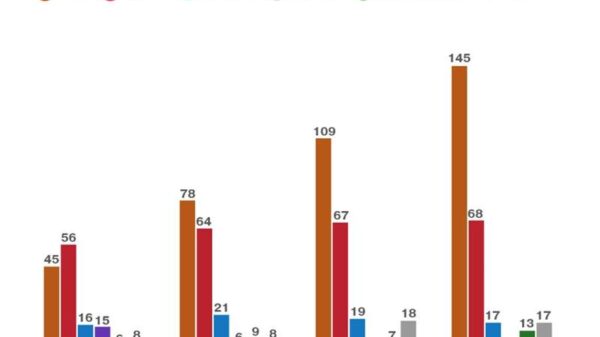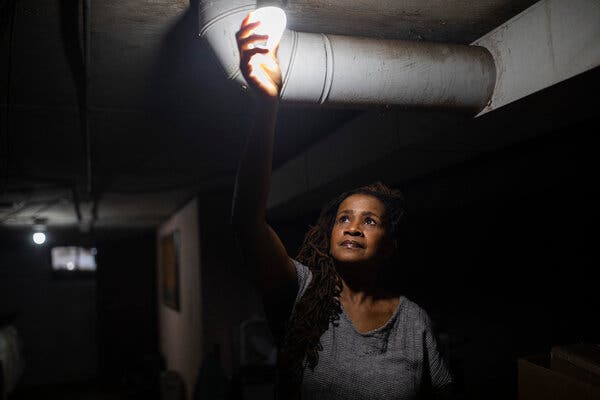LED lights are far more efficient, but there’s still money to be made from older bulbs.
We’re also covering a battle over rooftop solar panels in California, the life and death of a very big iceberg in the Southern Ocean, and the prospects for climate action in Congress.
It’s one of the simplest, easiest and cheapest ways to drastically shrink your electricity bills, and your climate footprint: switch out your old incandescent lights for energy-efficient LED bulbs.
A big market shift toward LEDs has brought about an energy efficiency revolution in the United States and around the world. But in a new article, I explore how older incandescent bulbs live on, notably in lower-end retailers like dollar stores. That means some of the poorest households continue to miss out on a chance to benefit from the newer technology, experts say.
Lighting accounts for as much as a fifth of the average American household’s electricity bill, and lower-income households already spend a disproportionately large part of their income on utilities.
Behind the staying power of these older bulbs is an effort by major manufacturers to delay energy efficiency standards, allowing them to prolong profits from a dying industry.
Why it matters: The older bulbs are slowing America’s overall energy efficiency gains. About 30 percent of standard light bulbs sold in the country in 2020 were inefficient incandescent or halogen bulbs. (That figure excludes California, which phased out most inefficient light bulbs.) In the European Union, the older bulbs are barely sold at all.
From the Opinion section: Russia and climate
President Vladimir V. Putin has something bigger to worry about at home than anything that happens in Ukraine, Thomas L. Friedman writes.
A battle over rooftop solar in California
There’s a nasty fight in California over solar power.
The dispute is about who will get to build the green energy economy and reap billions of dollars in profits. On one side are the smaller companies that install household solar panels and batteries. On the other are big utilities and their labor unions.
For years, the utilities and unions have lobbied regulators to rein in the rooftop solar business. Now, that effort is on the cusp of success. State regulators plan to vote in the next few weeks on a proposal that would reduce the growth of rooftop solar energy in the state and force Californians to rely more on large-scale power installations, including solar and wind farms, and on long-distance transmission lines operated by the big utilities.
Energy experts say the fight couldn’t come at a worse time. To find out why, you can read my article here.
Why it matters: At stake is whether California can reach its goal of 100 percent clean energy by 2045.
Related: A wildfire that erupted in California over the weekend seemed to stun even those intimately familiar with the state’s ongoing drought and its seemingly endless fire season.
We’ll never forget you, A68a
All icebergs eventually melt and break up, and the Antarctic berg known as A68a was no exception. It broke off the Larsen C ice shelf into the Weddell Sea in 2017, and, after drifting and melting for more than a thousand miles, disintegrated about a year ago near the island of South Georgia.
So, no big deal. Except that A68a was a big deal of an iceberg. Roughly the size of Delaware, for a brief frozen moment it was the largest berg in the world, and the sixth-largest ever seen. So when it melted, a lot of water was released into the ocean — about 150 billion tons near South Georgia alone, researchers estimate.
Understand the Latest News on Climate Change
Gone, but not forgotten. A68a, one of the biggest icebergs ever seen, broke off an ice shelf on the Antarctic Peninsula in 2017, drifted slowly for a few years and eventually melted in 2021. Here is what new research tells us about its journey and potential effects.
Such a huge volume of fresh water doesn’t necessarily mix immediately. It’s less dense, so it can sit in a layer on top of the saltier seawater. That can affect the health and variety of phytoplankton and other small organisms that are at the base of the food web in the region. Close to the top of that food web are penguins and seals, and millions of them call South Georgia home. So as I wrote in an article this week, scientists are studying whether the watery demise of A68a is having an effect on ecosystems around the island.
Fun iceberg fact: Why do Antarctic icebergs have such mundane names? All large ones that are tracked are named according to a convention established by the U.S. National Ice Center. So A68a was created in the “A” quadrant of the continent, it was the 68th “A” berg to be large enough to be tracked, and when a small berg broke off of it, it became A68a, and the smaller one became A68b.
Also important this week:
-
Even low levels of soot can be deadly to older people, new research has found.
-
The Environmental Protection Agency is planning stepped-up enforcement and monitoring to help disadvantaged communities struggling with polluted air and water.
-
Jonathan Pershing, the Biden administration’s No. 2 global climate envoy, plans to leave his position next month.
-
Lisa Goddard, a climate scientist at Columbia University who helped government agencies around the world predict extreme weather events, has died at 55.
And finally:
How climate action could still move forward in Congress
President Biden’s $2.2 trillion Build Back Better spending bill is stalled. But a growing number of Democrats in Congress want to move ahead with the climate portion of the package, and they say they believe they can muster enough votes to muscle it past Republican opposition.
The sweeping climate change and social policy bill has passed the House, but it ran into trouble last month when Senator Joe Manchin III, a West Virginia Democrat, said he opposed it. That, along with the fact that all Republicans in the chamber oppose the package, effectively brought the act to a screeching halt.
But Mr. Manchin has suggested that he might back various climate provisions in the legislation, leading some Democrats to say the party should regroup around a climate bill.
Mr. Biden endorsed the strategy during a news conference last week, saying that he was “confident we can get pieces, big chunks” of the bill passed. “I’ve been talking to a number of my colleagues on the Hill,” Mr. Biden said. “I think it’s clear that we would be able to get support for the $500 billion plus for energy and the environment.”
As I wrote with my climate team colleague Lisa Friedman, though, that strategy, which would mean abandoning other elements of the plan, like lower costs for prescription drugs, comes with some big political risks for Democrats.
If you’re not getting Climate Fwd: in your inbox, you can sign up here
We’d love your feedback on the newsletter. We read every message, and reply to many! Please email thoughts and suggestions to climateteam@nytimes.com.


































